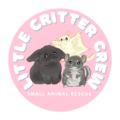About
To be ready for mice you will need
- Large enclosure (40+-gallon tank or bin cage is recommended)
- Quality rat/mouse pellets (Science selective, Oxbow Essentials, or Mazuri) and a quality seed mix (Sunseed Prima mix, Vita Garden, Higgin’s)
- Glass Water Bottle – Mice can chew up plastic bottles.
- Hides & Toys – Mice need lots of things to climb, hide, and interact with.
- Chews – wooden chews to help wear down their teeth. Apple and willow sticks are commonly used.
- Bedding – 4-6” of paper-based, or shredded paper. Aspen and hemp bedding are safe choices as well. Avoid aromatic bedding like cedar.
- Hard-sided Travel Carrier
- Small shop vac for cleaning up after your mice – optional but useful
- A wheel that is 10-12 inches. Solid bottom wheels with no crossbars are safe.
*Please understand that some items will need to be replenished monthly
Enclosures
Mice are inquisitive and curious, which means they become bored easily. Providing a large cage in addition to a lot of enrichment is absolutely essential to keep your mice happy.
They enjoy being able to burrow and make tunnels so bedding should be at least 3 inches deep in one section of the cage. Mice are also known to be escape artists so a cage with no bars and a secure mesh lid is best. Tanks, terrariums, and glass enclosures are commonly used.
Mouse Care
Feeding – Most food bought at pet stores is not suitable for mice because they contain too much corn, more protein than is healthy, and alfalfa pellets that they can’t digest. Your mice should get fresh foods in addition to a pellet/block diet and a seed mix like Higgins.
Chews – A mouse’s teeth grow throughout their lives so having access to chews and other toys will help them keep their teeth properly worn.
Bedding – Paper-based bedding or shredded paper will help soak up urine. Using hemp bedding along with aspen or hay (that is not dusty or has excess small particles) can assist with odor control. Bedding containing pine and cedar are not recommended as they can cause respiratory inflammation.
Cleaning the Enclosure
You should spot-clean the cage every day. Dirty bedding, rotten food, feces, and urine should be removed daily. Mice need an environment that is as clean as possible to prevent respiratory disease and other illnesses.
Wipe down surfaces 1-2 times a week (may need more for heavily soiled areas) change half of the bedding every 2-4 weeks.
Health
You will need to keep in mind that mice may need vet visits just like any other pet. Mice are prone to respiratory disease, skin conditions, and tumors. Unfortunately, many vets are not familiar with treating pocket pets. Just because a vet will see your mouse doesn’t mean they have the needed experience and knowledge. You will want to find a vet that is trained in small exotics. We recommend that you have a savings account for vet emergencies or set up a Care Credit account that will allow you to pay for the bill in increments over a year. Mice have extremely sensitive respiratory systems. For this reason, air fresheners, candles, and wax melts should not be used.
Traveling
Your mice will need a carrier for trips to the veterinarian and when they come home with you. Moves can be stressful so include some bedding or a hide for them to keep comfortable. If traveling further a larger carrier may be needed so that your mice have access to food and water.
Socializing and Bonding
It is important to build trust with your mice by letting them smell your hand, offering treats, and talking to them. Playpens are great for socializing and mental stimulation out of the cage. Keep in mind, mice are prey species and it is normal for them to be fearful of you. Most mice are not friendly by nature and in order to curb their urge to flee you will need to work at befriending them.
How to pick up your Mouse
It is best not to pick them up until they are comfortable with you touching them. You can do so by cupping your hands underneath them or letting them crawl onto your hand. Do not pick them up from above. Doing so may frighten them. Try speaking to them before you pick them up so they know you are there.
Holding your Mouse
Holding your mouse is best held close to your body without squeezing. Please be sure you are sitting on the ground when holding them to prevent accidental falls. After a while, you may find your mouse likes hiding in your clothing such as your hoodie.
We DO NOT recommend the following
- Small Enclosures – 20 gallon tanks do not leave much room for enrichment
- Plastic (hamster type) exercise balls aka death balls.
- Inappropriately sized wheels (under 8”), or wheels made of barred, mesh, or wire wheels
- Poor Quality Foods
- Cedar, Softwood, unknown woods.
- Cotton or fibrous bedding
- Snak Shaks or Logs
- Harnesses or Leashes can break fragile bones
Learn More
Further information on your pet mice can be found here (remember, pet owners can continuously learn how to better care for their furry friends with research).
